Norway’s election campaign season is relatively short, with an official launch in August and running until Election Day, the second Monday in September. Members of all nine political parties currently represented in Parliament, though, have been jockeying for power since the last election. Here’s a guide to where they stand on key issues in this year’s campaign and in the latest polls, as they try to appeal to voters from traditional campaign booths set up in towns and cities all over the country:
 The Conservative Party (Høyre)‘s campaign booth in Oslo features a large photo of Ine Eriksen Søreide, now Norway’s foreign minister and top candidate for Parliament from Oslo. The Conservatives are firmly led, however, by Prime Minister Erna Solberg (age 60), who also has led a government coalition on the right-center side of Norwegian politics for the past eight years. They’re seeking a third term of government power but seem unlikely to succeed, according to public opinion polls. The Conservatives, with 21.1 percent of the vote in August, promote a combination of personal freedom and social responsibility (see their own list of goals, in English and other languages, here) championing job creation and large transport projects while also campaigning to “cut emissions, not development.” Solberg has won praise over how her government tackled the Corona crisis, but climate-concerned voters can’t understand how the party can meet emissions-reduction goals while still supporting oil and gas exploration.
The Conservative Party (Høyre)‘s campaign booth in Oslo features a large photo of Ine Eriksen Søreide, now Norway’s foreign minister and top candidate for Parliament from Oslo. The Conservatives are firmly led, however, by Prime Minister Erna Solberg (age 60), who also has led a government coalition on the right-center side of Norwegian politics for the past eight years. They’re seeking a third term of government power but seem unlikely to succeed, according to public opinion polls. The Conservatives, with 21.1 percent of the vote in August, promote a combination of personal freedom and social responsibility (see their own list of goals, in English and other languages, here) championing job creation and large transport projects while also campaigning to “cut emissions, not development.” Solberg has won praise over how her government tackled the Corona crisis, but climate-concerned voters can’t understand how the party can meet emissions-reduction goals while still supporting oil and gas exploration.
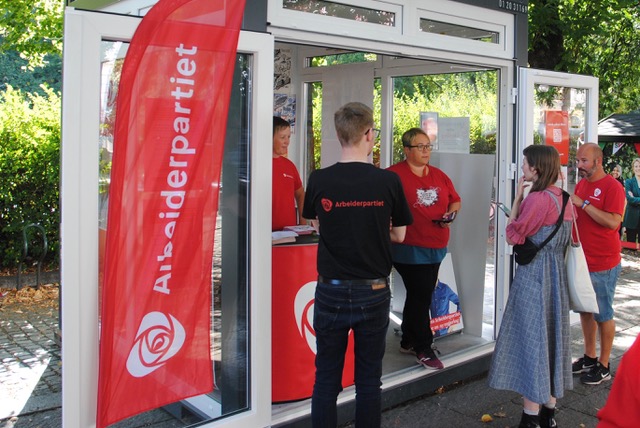 That’s also a problem for the Labour Party (Arbeiderpartiet), Norway’s other large, so-called “steering” party that has most often led the Norwegian government since World War II. Labour has been pro-oil for years, tarnishing its own climate- and environmental image despite claims that it, too, will slash emissions by raising taxes and fees on fossil fuel use, investing in more electrification, hydrogen and public transport projects, and establishing more carbon capture and storage plants. Labour, which calls itself a “social democratic,” not socialist party (external link to Labour’s English-language site), is led by Jonas Gahr Støre (age 61), a former foreign minister in the last left-center government who now wants to take over as prime minister by leading a left-center coalition made up of the Center- and Socialist Left parties. Recent polls, however, indicate the three no longer command a majority and likely will need to rely on support from parties father to the left.
That’s also a problem for the Labour Party (Arbeiderpartiet), Norway’s other large, so-called “steering” party that has most often led the Norwegian government since World War II. Labour has been pro-oil for years, tarnishing its own climate- and environmental image despite claims that it, too, will slash emissions by raising taxes and fees on fossil fuel use, investing in more electrification, hydrogen and public transport projects, and establishing more carbon capture and storage plants. Labour, which calls itself a “social democratic,” not socialist party (external link to Labour’s English-language site), is led by Jonas Gahr Støre (age 61), a former foreign minister in the last left-center government who now wants to take over as prime minister by leading a left-center coalition made up of the Center- and Socialist Left parties. Recent polls, however, indicate the three no longer command a majority and likely will need to rely on support from parties father to the left.
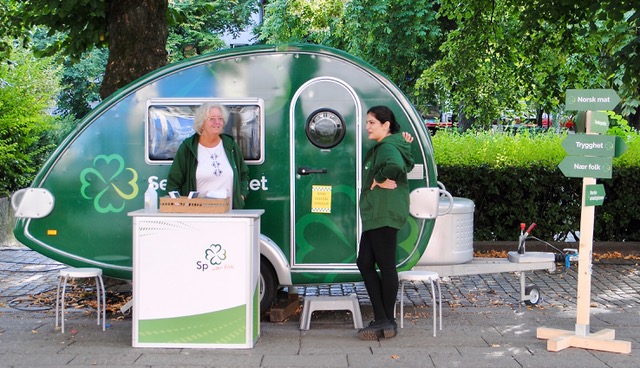 Norway’s other seven parties in Parliament are thus poised to play key roles in getting legislation passed or blocked over the next four years. Among the most eager to assert itself is the Center Party (Senterpartiet, Sp), with roots as the Farmers’ Party in Norway and still keen to pit rural districts against urban ones to its own advantage. Party leader Trygve Slagsvold Vedum (age 42) has been accused by Støre himself of stirring up “artificial” conflicts between urban and rural residents, but both complain about the current conservative government’s drive for consolidation and centralization of everything from hospitals to entire regions to create better economies of scale. Center is also pro-oil, arguably even moreso than Labour, and has struggled to convince voters that it’s concerned about the climate, too. Center is best-known as being a firmly anti-EU party that also has argued for either replacing or “improving” Norway’s current trade agreement with the EU. That worries most all industries in Norway, while Vedum has tried to moderate his allegedly populist and protectionist views in recent weeks. Center offers no information in English on its website, but much can be found about the party here.
Norway’s other seven parties in Parliament are thus poised to play key roles in getting legislation passed or blocked over the next four years. Among the most eager to assert itself is the Center Party (Senterpartiet, Sp), with roots as the Farmers’ Party in Norway and still keen to pit rural districts against urban ones to its own advantage. Party leader Trygve Slagsvold Vedum (age 42) has been accused by Støre himself of stirring up “artificial” conflicts between urban and rural residents, but both complain about the current conservative government’s drive for consolidation and centralization of everything from hospitals to entire regions to create better economies of scale. Center is also pro-oil, arguably even moreso than Labour, and has struggled to convince voters that it’s concerned about the climate, too. Center is best-known as being a firmly anti-EU party that also has argued for either replacing or “improving” Norway’s current trade agreement with the EU. That worries most all industries in Norway, while Vedum has tried to moderate his allegedly populist and protectionist views in recent weeks. Center offers no information in English on its website, but much can be found about the party here.
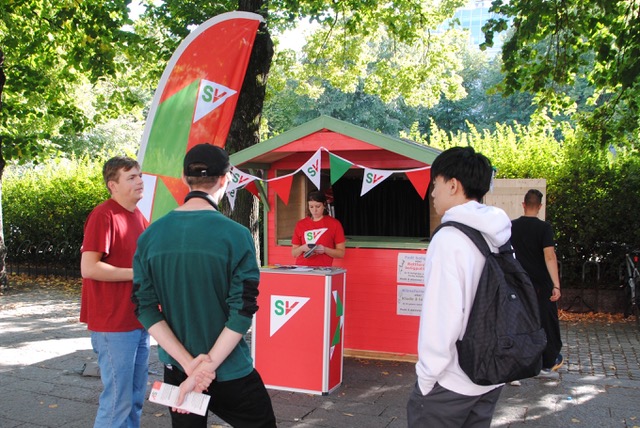 The Socialist Left Party (Socialistisk Venstreparti, SV) has been invited by Labour, but not Center, to join a new three-party left-center coalition government like the one they formed to hold power from 2005 to 2013, when the Conservatives unseated them. SV leader Audun Lysbakken (age 43) leads a party that battles social differences among people and wants a tax system aimed at redistributing wealth. Like Labour, SV thinks the wealthy should pay higher tax on their income and net worth, while those with moderate incomes (under NOK 750,000/USD 86,000, according to Labour) should pay less. Lysbakken and his fellow party members, though, differ sharply from both Labour and Center on oil policy, calling for a halt to all further exploration and gas and tougher measures to cut emissions than Labour and Center support. (See SV’s own information in English here.) That can force Labour and Center to seek compromises and support from other parties that won’t issue the oil ultimatum that SV has, but are keen to exert influence in other areas.
The Socialist Left Party (Socialistisk Venstreparti, SV) has been invited by Labour, but not Center, to join a new three-party left-center coalition government like the one they formed to hold power from 2005 to 2013, when the Conservatives unseated them. SV leader Audun Lysbakken (age 43) leads a party that battles social differences among people and wants a tax system aimed at redistributing wealth. Like Labour, SV thinks the wealthy should pay higher tax on their income and net worth, while those with moderate incomes (under NOK 750,000/USD 86,000, according to Labour) should pay less. Lysbakken and his fellow party members, though, differ sharply from both Labour and Center on oil policy, calling for a halt to all further exploration and gas and tougher measures to cut emissions than Labour and Center support. (See SV’s own information in English here.) That can force Labour and Center to seek compromises and support from other parties that won’t issue the oil ultimatum that SV has, but are keen to exert influence in other areas.
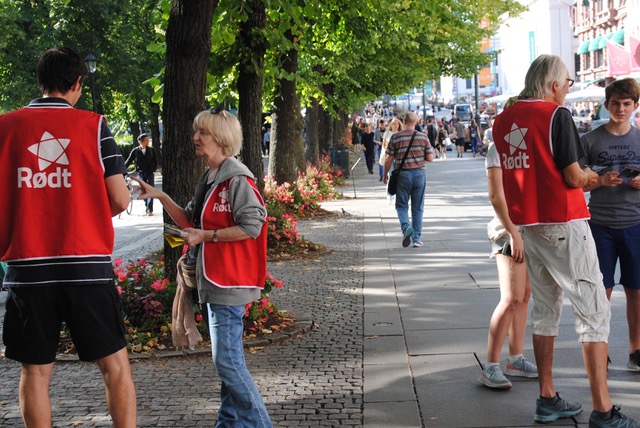 That can include the Reds Party (Rødt), which has come on strong during the past few years under the leadership of 39-year-old Bjørnar Moxnes, who communicates clearly and has contributed towards settling several decisive issues in Parliament. The party is extremely clear about its campaign to confront and fight “increasing inequality” in Norway, redistributing wealth through taxes and closing the gap between rich and poor. It also wants to rein in the oil industry to fight climate change, but appears more willing to negotiate that point than SV. Like SV and the Center Party, the Reds are also adamantly against joining the EU and want to replace Norway’s current trade and policy agreement with the EU with a pure trade deal. It claims it won’t join any government, however, since it doesn’t support the capitalist system, but seeks influence and often is the first to comment on issues, with the other parties following the Reds lead. The Reds offer extensive information about their party program in English here.
That can include the Reds Party (Rødt), which has come on strong during the past few years under the leadership of 39-year-old Bjørnar Moxnes, who communicates clearly and has contributed towards settling several decisive issues in Parliament. The party is extremely clear about its campaign to confront and fight “increasing inequality” in Norway, redistributing wealth through taxes and closing the gap between rich and poor. It also wants to rein in the oil industry to fight climate change, but appears more willing to negotiate that point than SV. Like SV and the Center Party, the Reds are also adamantly against joining the EU and want to replace Norway’s current trade and policy agreement with the EU with a pure trade deal. It claims it won’t join any government, however, since it doesn’t support the capitalist system, but seeks influence and often is the first to comment on issues, with the other parties following the Reds lead. The Reds offer extensive information about their party program in English here.
 The Greens Party (Miljøpartiet De Grønne, MDG), meanwhile, has been making strong showings on the local and national political scene in Norway since the last election. The Greens hold city government power in Oslo, where they’ve worked hard to remove street parking and make it difficult and expensive to drive in the city. Now the party wants much more say at the national level, encouraged by polls showing enough voter support (more than 4 percent) for at least one additional seat in Parliament. Propelled by climate concerns above all others, the Greens are firmly anti-oil and all other fossil forms of energy, demanding an immediate halt to oil exporation and a phase-out of the industry. The party is often criticized as being too authoritarian and impatient for change, showing little sympathy for those who still need or want to use their cars. It was long reluctant to have an actual party leader, but 35-year-old Une Bastholm ended up taking on the role and has performed well in party leader debates. The Greens are the only party to not have a staffed election booth in downtown Oslo, opting instead to simply post the above signs and claim its members were too busy out trying to save the planet from climate change to chat with potential voters. The party also has no page on its website with information in English, even though it has come out in favour of EU membership in order to better influence EU climate policy to which Norway adheres.
The Greens Party (Miljøpartiet De Grønne, MDG), meanwhile, has been making strong showings on the local and national political scene in Norway since the last election. The Greens hold city government power in Oslo, where they’ve worked hard to remove street parking and make it difficult and expensive to drive in the city. Now the party wants much more say at the national level, encouraged by polls showing enough voter support (more than 4 percent) for at least one additional seat in Parliament. Propelled by climate concerns above all others, the Greens are firmly anti-oil and all other fossil forms of energy, demanding an immediate halt to oil exporation and a phase-out of the industry. The party is often criticized as being too authoritarian and impatient for change, showing little sympathy for those who still need or want to use their cars. It was long reluctant to have an actual party leader, but 35-year-old Une Bastholm ended up taking on the role and has performed well in party leader debates. The Greens are the only party to not have a staffed election booth in downtown Oslo, opting instead to simply post the above signs and claim its members were too busy out trying to save the planet from climate change to chat with potential voters. The party also has no page on its website with information in English, even though it has come out in favour of EU membership in order to better influence EU climate policy to which Norway adheres.
 The Greens’ exact opposite from a political perspective is the Progress Party (Fremskrittspartiet, Frp). Progress, Norway’s most right-wing party in Parliament, is the strongest supporter of what it calls “Norway’s most important industry” (offshore oil and gas) because of all the jobs it creates, and firmly refuses to halt further oil and gas exploration. The party also champions use of private cars and road projects and was long branded as being in climate change denial. The party and its controversial new leader Sylvi Listhaug (age 43) now acknowledges climate change but prefers to pay other countries to cut their emissions, opposes high climate-related taxes and fees and insists that Norway’s oil and gas industry is much “cleaner” than other countries’ and must therefore continue to expand. It will cut emissions by planting more trees and supporting hydrogen and biogas projects along with oil and gas. Progress is best known for restricting immigration and acceptance of asylum seekers, but that’s not a big issue in this election since the Corona crisis closed borders and cut off what few would-be immigrants were still trying to move to Norway, apart from the Afghan refugees recently flown in. The party also has had elder care on its list but failed to make much progress when it even won a government post devoted to elder care before it withdrew from the Conservatives-led coalition early last year. Most commentators claim Progress has given up on this year’s election, opting instead to rebuild its base in time for the next election in 2025. It offers no information in English on its website.
The Greens’ exact opposite from a political perspective is the Progress Party (Fremskrittspartiet, Frp). Progress, Norway’s most right-wing party in Parliament, is the strongest supporter of what it calls “Norway’s most important industry” (offshore oil and gas) because of all the jobs it creates, and firmly refuses to halt further oil and gas exploration. The party also champions use of private cars and road projects and was long branded as being in climate change denial. The party and its controversial new leader Sylvi Listhaug (age 43) now acknowledges climate change but prefers to pay other countries to cut their emissions, opposes high climate-related taxes and fees and insists that Norway’s oil and gas industry is much “cleaner” than other countries’ and must therefore continue to expand. It will cut emissions by planting more trees and supporting hydrogen and biogas projects along with oil and gas. Progress is best known for restricting immigration and acceptance of asylum seekers, but that’s not a big issue in this election since the Corona crisis closed borders and cut off what few would-be immigrants were still trying to move to Norway, apart from the Afghan refugees recently flown in. The party also has had elder care on its list but failed to make much progress when it even won a government post devoted to elder care before it withdrew from the Conservatives-led coalition early last year. Most commentators claim Progress has given up on this year’s election, opting instead to rebuild its base in time for the next election in 2025. It offers no information in English on its website.
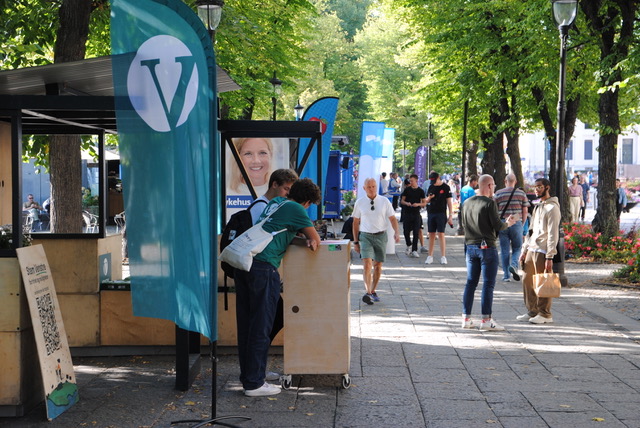 The Liberal Party (Venstre) is, despite its name, currently the Conservatives’ biggest hope as a government partner or simply supporter in Parliament. It joined the Conservatives’ government coalition in 2018 after having supported Erna Solberg’s earlier minority government with Progress since 2013. The Liberals have been sinking in the polls for more than the past year but, under the new leadership of 40-year-old Guri Melby, the party has recently risen above the level needed for full representation in Parliament and won strong support in this week’s mock election among high school students. It represents a mix of conservative economic policy combined with strong measures to protect the climate, environment and wildlife. It also now supports membership in the EU (which the Conservatives support, too, but won’t put it back on the political agenda since a majority of the public still opposes EU membership). The Liberals support an end to oil exploration while allowing production to continue with electrification of oil platforms to reduce their emissions. It’s long been a champion of strong schools and universities, supports immigration and integration, and played a key role in finally allowing dual citizenship in Norway. It offers a comprehensive list of its positions and party information in English on its own website.
The Liberal Party (Venstre) is, despite its name, currently the Conservatives’ biggest hope as a government partner or simply supporter in Parliament. It joined the Conservatives’ government coalition in 2018 after having supported Erna Solberg’s earlier minority government with Progress since 2013. The Liberals have been sinking in the polls for more than the past year but, under the new leadership of 40-year-old Guri Melby, the party has recently risen above the level needed for full representation in Parliament and won strong support in this week’s mock election among high school students. It represents a mix of conservative economic policy combined with strong measures to protect the climate, environment and wildlife. It also now supports membership in the EU (which the Conservatives support, too, but won’t put it back on the political agenda since a majority of the public still opposes EU membership). The Liberals support an end to oil exploration while allowing production to continue with electrification of oil platforms to reduce their emissions. It’s long been a champion of strong schools and universities, supports immigration and integration, and played a key role in finally allowing dual citizenship in Norway. It offers a comprehensive list of its positions and party information in English on its own website.
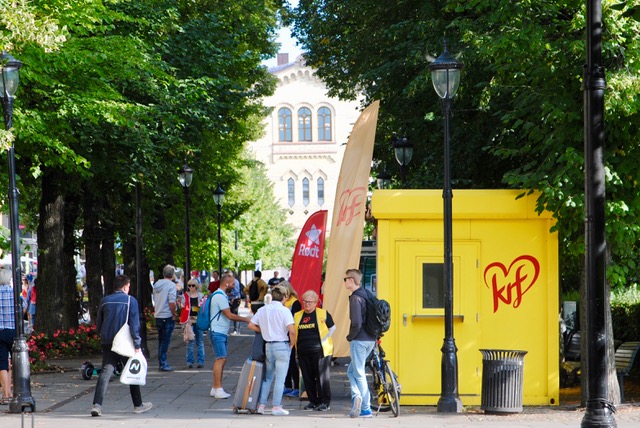 The smallest of the parties seeking voter support on Monday is the ailing Christian Democrats Party (Kristelig Folkeparti, KrF), which, like the Liberals, is currently a member of the Conservatives’ led government coalition. Its dive in the polls over the past year (to just around 3 percent in the most recent), along with the departure of Progress, is largely responsible for spoiling Prime Minister Solberg’s hopes of winning a third term. Its 36-year-old leader Kjell Ingolf Ropstad is widely viewed as providing the last nail in the coffin this week when newspaper Aftenposten revealed how he’s exploited and even earned money on the state’s all-expenses-paid housing system in Oslo. It’s the Christian Democrats’ views on issues that are often viewed as old-fashioned in Norway, and some political commentators think the party has become “irrelevant” and that its very existence is under threat. That’s bad news for the conservative side of Norwegian politics, since the party used to be a major centrist force and even led non-socialist governments in the late 1990s and early 2000s. Its new proposals such as an extra week of paid holiday for parents with small children, more financial support for Norwegians who opt to stay home with their children instead of sending them to state-subsidized day care centers, and extended parental leave are also expensive for any new government. The anti-EU party does offer information in English and several other languages on its website, and has actively tried to gain support from the immigrant community.
The smallest of the parties seeking voter support on Monday is the ailing Christian Democrats Party (Kristelig Folkeparti, KrF), which, like the Liberals, is currently a member of the Conservatives’ led government coalition. Its dive in the polls over the past year (to just around 3 percent in the most recent), along with the departure of Progress, is largely responsible for spoiling Prime Minister Solberg’s hopes of winning a third term. Its 36-year-old leader Kjell Ingolf Ropstad is widely viewed as providing the last nail in the coffin this week when newspaper Aftenposten revealed how he’s exploited and even earned money on the state’s all-expenses-paid housing system in Oslo. It’s the Christian Democrats’ views on issues that are often viewed as old-fashioned in Norway, and some political commentators think the party has become “irrelevant” and that its very existence is under threat. That’s bad news for the conservative side of Norwegian politics, since the party used to be a major centrist force and even led non-socialist governments in the late 1990s and early 2000s. Its new proposals such as an extra week of paid holiday for parents with small children, more financial support for Norwegians who opt to stay home with their children instead of sending them to state-subsidized day care centers, and extended parental leave are also expensive for any new government. The anti-EU party does offer information in English and several other languages on its website, and has actively tried to gain support from the immigrant community.
Voting in advance of Monday’s election ends on Friday. Polls will be open in some Norwegian cities on Sunday and then all day Monday. The first election results are due Monday night, but given speculation that it may be difficult for any bloc to emerge with a firm majority, government negotiations can continue for several days.
ALL PHOTOS: newsinenglish.no/Morten Møst
newsinenglish.no/Nina Berglund

